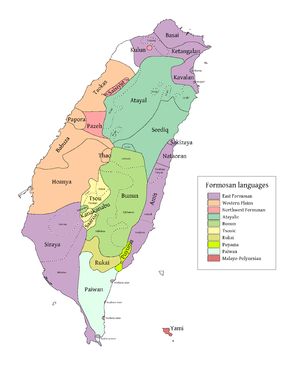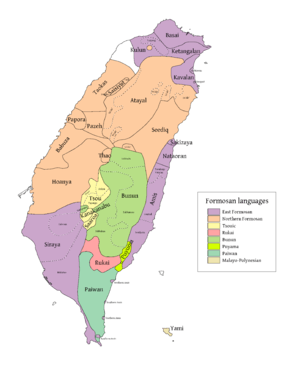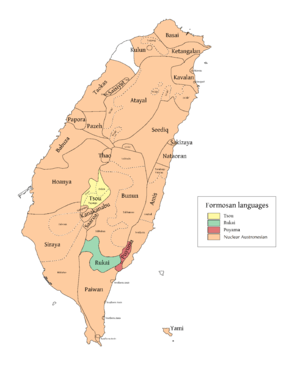Formosan languages
| Formosan | |
|---|---|
| Ethnicity: | Taiwanese aborigines |
| Geographic distribution: | Taiwan |
| Linguistic classification: |
|
| Subdivisions: | |
| ISO 639-5: | fox |
| Glottolog: | None |
|
Families of Formosan languages before Chinese colonization, per Blust (1999). Malayo-Polynesian (red) may lie within Eastern Formosan (purple). | |
The Formosan languages are the languages of the indigenous peoples of Taiwan. Taiwanese aborigines (those recognized by the government) currently comprise about 2.3% of the island's population. However, far fewer can still speak their ancestral language, after centuries of language shift. Of the approximately 26 languages of the Taiwanese aborigines, at least ten are extinct, another four (perhaps five) are moribund,[1][2] and several others are to some degree endangered.
The aboriginal languages of Taiwan have significance in historical linguistics, since in all likelihood Taiwan was the place of origin of the entire Austronesian language family. According to linguist Robert Blust, the Formosan languages form nine of the ten principal branches of the Austronesian language family,[3] while the one remaining principal branch contains nearly 1,200 Malayo-Polynesian languages found outside of Taiwan.[4] Although linguists disagree with some details of Blust's analysis, a broad consensus has coalesced around the conclusion that the Austronesian languages originated in Taiwan.[5] This theory has been strengthened by recent studies in human population genetics, supporting also the matrilineal nature of the migration.[6]
Recent history
All Formosan languages are slowly being replaced by the culturally dominant Standard Chinese. In recent decades the Republic of China government started an aboriginal reappreciation program that included the reintroduction of Formosan first language in Taiwanese schools. However, the results of this initiative have been disappointing.[7]
In 2005, in order to preserve the language of the indigenous people of Taiwan, the council established a Romanized writing system for all Taiwan's aboriginal languages. The council has also helped with classes and language certification programs for members of the indigenous community and the Han Chinese to help the conservation movement.[8]
Classification
There are various classifications of Formosan languages. These deny that the Formosan languages form a coherent language family apart from Austronesian.
List of languages
It is often difficult to decide where to draw the boundary between a language and a dialect, causing some minor disagreement among scholars regarding the inventory of Formosan languages. There is even more uncertainty regarding many extinct or assimilated Formosan tribes, since our knowledge of these is often sketchy at best. Frequently cited examples of Formosan languages are given below, but the list should not be considered exhaustive.
Living languages
- Atayal (high dialect diversity, sometimes considered separate languages)
- Bunun (high dialect diversity)
- Amis
- Kanakanabu (moribund)
- Kavalan (listed in some sources[1] as moribund, though further analysis may show otherwise[9])
- Kaxabu
- Paiwan
- Saisiyat
- Puyuma
- Rukai (high dialect diversity)
- Saaroa (moribund)
- Seediq (AKA Truku)
- Thao (moribund)
- Tsou
Also in Taiwan, but not Formosan:
- Yami (AKA Tao)
Extinct languages
Syntax
Most Formosan languages display verb-initial syntax (VSO (verb-subject-object) or VOS (verb-object-subject) with the exception of some Northern Formosan languages, such as Thao, Saisiyat, and Pazih, possibly from influence from Chinese.
Li (1998) lists the word orders of several Formosan languages.[10]
- Rukai: VSO, VOS
- Tsou: VOS
- Bunun: VSO
- Atayal: VSO, VOS
- Saisiyat: VS, SVO
- Pazih: VOS, SVO
- Thao: VSO, SVO
- Amis: VOS, VSO
- Kavalan: VOS
- Puyuma: VSO
- Paiwan: VSO, VOS
Sound changes
Tanan Rukai is the Formosan language with the largest number of phonemes with 23 consonants and 4 vowels containing length contrast, while Kanakanabu and Saaroa have the least number of phonemes with 13 consonants and 4 vowels (Blust 2009:165).
Wolff
The tables below list the Proto-Austronesian reflexes of individual languages given in John Wolff's Proto-Austronesian phonology with glossary (2010).[11]
| Proto-Austronesian | Pazih | Saisiat | Thao | Atayalic |
|---|---|---|---|---|
| *p | p | p | p | p |
| *t | t, s | t, s, ʃ | t, θ | t, c (s) |
| *c | z [dz] | h | t | x, h |
| *k | k | k | k | k |
| *q | Ø | ʔ | q | q, ʔ |
| *b | b | b | f | b- |
| *d | d | r | s | r |
| *j | d | r | s | r |
| *g | k-, -z- [dz], -t | k-, -z- [ð], -z [ð] | k-, -ð-, -ð | k-[12] |
| *ɣ | x | l [ḷ] (> Ø in Tonghœʔ) | ɬ | ɣ, r, Ø |
| *m | m | m | m | m |
| *n | n | n | n | n |
| *ŋ | ŋ | ŋ | n | ŋ |
| *s | s | ʃ | ʃ | s |
| *h | h | h | Ø | h |
| *l | r | l [ḷ] (> Ø in Tonghœʔ) | r | l |
| *ɬ | l | ɬ | ð | l |
| *w | w | w | w | w |
| *y | y | y | y | y |
| Proto-Austronesian | Saaroa | Kanakanavu | Rukai | Bunun | Amis | Kavalan | Puyuma | Paiwan |
|---|---|---|---|---|---|---|---|---|
| *p | p | p | p | p | p | p | p | p |
| *t | t, c | t, c | t, c | t | t | t | t, ʈ | tj [č], ts [c] |
| *c | s, Ø | c | θ, s, Ø | c ([s] in Central & South) | c | s | s | t |
| *k | k | k | k | k | k | k, q | k | k |
| *q | Ø | ʔ | Ø | q (x in Ishbukun) | ɦ | Ø | ɦ | q |
| *b | v | v [β] | b | b | f | b | v [β] | v |
| *d | s | c | ḍ | d | r | z | d, z | dj [j], z |
| *j | s | c | d | d | r | z | d, z | dj [j], z |
| *g | k-, -ɬ- | k-, -l-, -l | g | k-, -Ø-, -Ø | k-, -n-, -n | k-, -n-, -n | h-, -d-, -d | g-, -d-, -d |
| *ɣ | r | r | r, Ø | l | l [ḷ] | ɣ | r | Ø |
| *m | m | m | m | m | m | m | m | m |
| *n | n | n | n | n | n | n | n | n |
| *ŋ | ŋ | ŋ | ŋ | ŋ | ŋ | ŋ | ŋ | ŋ |
| *s | Ø | s | s | s | s | Ø | Ø | s |
| *h | Ø | Ø | Ø | Ø | h | Ø | Ø | Ø |
| *l | Ø | Ø, l | ñ | h-, -Ø-, -Ø | l [ḷ] | r, ɣ | l [ḷ] | l |
| *ɬ | ɬ | n | ɬ | n | ɬ | n | ɬ | ɬ |
| *w | Ø | Ø | v | v | w | w | w | w |
| *y | ɬ | l | ð | ð | y | y | y | y |
| Proto-Austronesian | Tagalog | Chamorro | Malay | Old Javanese |
|---|---|---|---|---|
| *p | p | f | p | p |
| *t | t | t | t | t |
| *c | s | s | s | s |
| *k | k | h | k | k |
| *q | ʔ | ʔ | h | h |
| *b | b | p | b, -p | b, w |
| *d | d-, -l-, -d | h | d, -t | ḍ, r |
| *j | d-, -l-, -d | ch | j, -t | d |
| *g | k-, -l-, -d | Ø | d-, -r-, -r | g-, -r-, -r |
| *ɣ | g | g | r | Ø |
| *m | m | m | m | m |
| *n | n | n | n | n |
| *ŋ | ŋ | ŋ | ŋ | ŋ |
| *s | h | Ø | h | h |
| *h | Ø | Ø | Ø | Ø |
| *l | l | l | l | l |
| *ɬ | n | ñ, n, l | l-/ñ-, -ñ-/-n-, -n | n |
| *w | w | w | Ø, w | w |
| *y | y | y | y | y |
Blust
The following table lists reflexes of Proto-Austronesian *j in various Formosan languages (Blust 2009:572).
| Language | Reflex |
|---|---|
| Tsou | Ø |
| Kanakanabu | l |
| Saaroa | ɬ (-ɬ- only) |
| Puyuma | d |
| Paiwan | d |
| Bunun | Ø |
| Atayal | r (in Squliq), g (sporadic), s (sporadic) |
| Sediq | y (-y- only), c (-c only) |
| Pazeh | z ([dz]) (-z- only), d (-d only) |
| Saisiyat | z ([ð]) |
| Thao | z ([ð]) |
| Amis | n |
| Kavalan | n |
| Siraya | n |
The following table lists reflexes of Proto-Austronesian *ʀ in various Formosan languages (Blust 2009:582).
| Language | Reflex |
|---|---|
| Paiwan | Ø |
| Bunun | l |
| Kavalan | ʀ (contrastive uvular rhotic) |
| Basay | l |
| Amis | l |
| Atayal | g; r (before /i/) |
| Sediq | r |
| Pazeh | x |
| Taokas | l |
| Thao | lh (voiceless lateral) |
| Saisiyat | L (retroflex flap) |
| Bashiic (extra-Formosan) | y |
Lenition patterns include (Blust 2009:604-605):
- *b, *d in Proto-Austronesian
- *b > f, *d > c, r in Tsou
- *b > v, *d > d in Puyuma
- *b > v, *d > d, r in Paiwan
- *b > b, *d > r in Saisiyat
- *b > f, *d > s in Thao
- *b > v, *d > r in Yami (extra-Formosan)
Distributions
|
Li (2001) lists the geographical homelands for the following Formosan languages.[13]
- Tsou: southwestern parts of central Taiwan; Yushan (oral traditions)
- Saisiyat and Kulon: somewhere between Tatu River and Tachia River not far from the coast
- Thao: Choshui River
- Qauqaut: mid-stream of Takiri River (Liwuhsi in Chinese)
- Siraya: Chianan Plains
- Makatau: Pingtung
- Bunun: Hsinyi (信義鄉) in Nantou County
- Paiwan: Ailiao River, near the foot of the mountains
See also
- Swadesh lists for Formosan languages (Wiktionary)
- Demographics of Taiwanese Aborigines
- Personal pronoun systems of Formosan languages
- Fossilized affixes in Austronesian languages
- Proto-Austronesian language
- Tsou language for an example of the unusual phonotactics of the Formosan languages
- Sinckan Manuscripts
- Naming customs of Taiwanese aborigines
Notes
- 1 2 Zeitoun, Elizabeth; Yu, Ching-Hua (1 July 2005). "The Formosan Language Archive: Linguistic Analysis and Language Processing". International Journal of Computational Linguistics and Chinese Language Processing. 10 (2): 167–200.
- ↑ Li, Paul Jen-kuei; Tsuchida, Shigeru (2006). Kavalan Dictionary (in English and Chinese). Taipei: Institute of Linguistics, Academia Sinica. ISBN 9789860069938.
- ↑ Blust, Robert (1999). Zeitoun, Elizabeth; Li, Jen-kuei, eds. "Subgrouping, circularity and extinction: some issues in Austronesian comparative linguistics". Selected papers from the Eighth International Conference on Austronesian Linguistics. Taipei: Academia Sinica. ISBN 9789576716324.
- ↑ Diamond, Jared M. (17 February 2000). "Taiwan's gift to the world". Nature. 403 (6771): 709–710. doi:10.1038/35001685.
- ↑ Fox, James (19–20 August 2004). Current Developments in Comparative Austronesian Studies. Symposium Austronesia, Pascasarjana Linguististik dan Kajian Budaya Universitas Udayana. ANU Research Publications. Bali. OCLC 677432806.
- ↑ Trejaut, Jean A; Kivisild, Toomas; Loo, Jun Hun; Lee, Chien Liang; He, Chun Lin; Hsu, Chia Jung; Li, Zheng Yuan; Lin, Marie; Penny, David (5 July 2005). "Traces of Archaic Mitochondrial Lineages Persist in Austronesian-Speaking Formosan Populations". PLoS Biology. 3 (8): e247. doi:10.1371/journal.pbio.0030247.
- ↑ Huteson, Greg. (2003). Sociolinguistic survey report for the Tona and Maga dialects of the Rukai Language. SIL Electronic Survey Reports 2003-012, Dallas, TX: SIL International.
- ↑ http://www.galdu.org/web/?odas=4584&giella1=eng
- ↑ Li & Tsuchida (2006).
- ↑ Li, Paul Jen-kuei. 1998. "台灣南島語言 [The Austronesian Languages of Taiwan]." In Li, Paul Jen-kuei. 2004. Selected Papers on Formosan Languages. Taipei, Taiwan: Institute of Linguistics, Academia Sinica.
- ↑ Wolff, John U. 2010. Proto-Austronesian phonology with glossary. Ithaca, NY: Cornell Southeast Asia Program Publications.
- ↑ There are several outcomes of *g as onset or coda of the final syllable.
- ↑ Li, Paul Jen-kuei. 2001. "The Dispersal of the Formosan Aborigines in Taiwan." Languages and Linguistics 2.1:271-278, 2001.
Bibliography
- Blust, Robert A. 2009. The Austronesian Languages. Canberra: Pacific Linguistics, Research School of Pacific and Asian Studies, Australian National University. ISBN 0-85883-602-5, ISBN 978-0-85883-602-0.
Further reading
- Blundell, David (2009), Austronesian Taiwan: Linguistics, History, Ethnology, Prehistory. Taipei, Taiwan: SMC Publishing
- Happart, G., & Hedhurst, W. H. (1840). Dictionary of the Favorlang dialect of the Formosan language. Batavia: printed at Parapattan.
- Li, Paul Jen-kuei (2004). "Basic Vocabulary for Formosan Languages and Dialects." In Li, Paul Jen-kuei. Selected Papers on Formosan Languages, vol. 2. Taipei, Taiwan: Institute of Linguistics, Academia Sinica.
- Mackay, G. L. (1893). Chinese Romanized dictionary of the Formosan vernacular. Shanghai: Printed at the Presbyterian Mission Press.
- Tsuchida, S. (2003). Kanakanavu texts (Austronesian Formosan). [Osaka?: Endangered Languages of the Pacific Rim].
- Zeitoun, E. (2002). Nominalization in Formosan languages. Taipei: Institute of Linguistics (Preparatory Office), Academia Sinica.
External links
- Ogawa's Vocabulary of Formosan Dialects 小川尚義 (臺灣蕃語蒐録)
- Academia Sinica's Formosan Language Archive project
- Linguistics and Formosan Languages
- Map: Formosan Languages and Yami (PDF)




